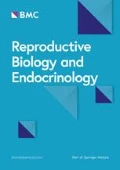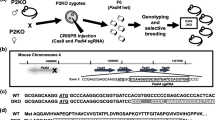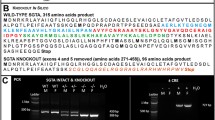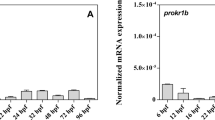Abstract
Background
C-type natriuretic peptide (CNP) signaling through its receptor natriuretic peptide receptor B (NPR-B) is a key molecule for mammalian reproduction, and known to play important roles in female fertility. However, the function of these peptides in mouse male reproduction remains largely unknown. To determine the role of CNP/NPR-B signaling in male reproduction we investigated phenotype of Npr2-deficient short-limbed-dwarfism (Npr2slw/slw) mice, which have been shown to have gastrointestinal (GI) abnormalities.
Findings
In homozygous Npr2slw/slw mice, spermatogenesis is developmentally delayed at both 2 and 4 weeks of age, with vacuolation and degenerating apoptotic germ cells being observed at 3 weeks age. However, the adult Npr2slw/slw mice exhibited apparently normal spermatogenesis, albeit with some aberrant spermatids, suggesting that developmental delay was overcome. In addition, the adult Npr2slw/slw mice showed abnormal penile morphology (paraphimosis).
Conclusions
The potential role of CNP signaling via the NPR-B receptor in male fertility appears to be mediated not through germ-cell development, but may be through maintenance of normal penile function.
Similar content being viewed by others
Findings
Background
The mouse Npr2 gene encodes natriuretic peptide receptor B, NPR-B (also known as NPR2), which is a known receptor for C-type natriuretic peptide, CNP (encoded by the Nppc gene, and also known as NPPC). NPR-B synthesizes intracellular cyclic guanosine monophosphate (cGMP) [1], which acts as a secondary messenger and is degraded by cGMP-specific phosphodiesterase type 5 (PDE5) [2]. The peptide and its receptor, CNP/NPR-B are expressed in the nervous and vascular systems [3–5], including the gastrointestinal tract [6], where they are thought to act as a local paracrine or autocrine regulators [5].
A number of reports have demonstrated an important role for CNP in reproductive regulation in females [7]. Although male Npr2 exhibit reduced reproductive functions, it is not known why male Npr2 mutants are infertile or sub-fertile. Most spontaneous Npr2slw/slw (SLW: Short-limbed dwarfism) males fail to mate, but a limited number of these mutants generated offspring [8]. Males homozygous for another spontaneous mutation, Npr2pwe/pwe (peewee mouse), were sub-fertile, but exhibited normal testis histology [9]. Interestingly, the male Npr2-KO mouse was infertile but exhibited normal spermatogenesis [10]. Observations on male reproduction were mentioned only briefly in these studies and not pursued in detail.
In a previous report, it was suggested that CNP/NPR-B signaling could lead to relaxation of seminiferous tubules and thereby regulate sperm transportation and testicular blood supply [11]. This signaling is also believed to modulate spermatozoa motility, testicular germ cell development and testosterone synthesis in mice [12]. In addition, it was also reported that CNP regulates blood-testis barrier (BTB) dynamics in adult rats [13]. These reports suggested that CNP is a key factor for spermatogenesis. Therefore, it might be expected that absence of NPR-B would also impact on spermatogenesis, and indeed, reduced fertility is a phenotype in several Npr2 mutants. However, the Npr2 mutant mice also exhibit other phenotypes that might ultimately affect fertility. For example, Npr2slw/slw mutants display gastrointestinal (GI) dysfunctions and high pre-weaning death, due to lack of CNP/NPR-B signaling [6, 14]. In the case of the few surviving Npr2slw/slw mice, the GI disorders might cause nutritional restriction, which is known to contribute to aberrant spermatogenesis and reduced number of germ cells [15, 16].
This study was undertaken to provide more complete and definitive observation using mice homozygous for a mutant allele of Npr2, Npr2slw, which could contribute to determination of a possible link between the CNP/NPR-B signaling pathway and male reproduction.
Methods
Mice
The Npr2slw mutant line, herein referred to as SLW mice were maintained under standard conditions. An inbred SLW strain was created by a single backcross to the ddY mouse (Japan SLC, Inc., Shizuoka, Japan), and subsequent mating between heterozygous mice. In this study, the mice used as comparative controls were either heterozygotes or wild type for the non-mutated allele; collectively they are referred to as control. All animal experiments were carried out in accordance with institutional guidelines regarding animal care and handling, and the experimental protocol was approved by the Institutional Animal Care and Use Committee of the National Institute of Radiological Sciences.
Histology and TUNEL assay
Testes were prepared and fixed in Bouin’s solution for 1 h (0 day postpartum (dpp)), 2 h (7 dpp), 4 h (14 dpp), overnight (21 dpp), and 24 h (28 dpp, 35 dpp, and adult) at room temperature (RT), and then immersed in 70% ethanol for 48 h. The specimens were dehydrated and embedded in paraffin. Subsequently, 2-μm-thick sections were cut, attached to glass slides (MAS-GP Type A; Matsunami Glass Ind., Ltd., Osaka, Japan), and then deparaffinized, rehydrated, and subjected to hematoxylin and eosin staining.
The TUNEL assay was performed for detection of apoptotic cells using ApopTag® Peroxidase in situ Apoptosis Detection Kit (CHEMICON® International, Inc. CA, USA) according to the manufacturer’s instructions.
Statistical analysis
Data are expressed as the means ± SD or SE. The statistical significance of differences in mean values was assessed by Student’s t-test.
Results
Developmental delay of spermatogenesis in juvenile but not adult Npr2mutant mice
As previously reported, the Npr2slw/slw mutant mice exhibited dwarfism and GI distention with gas (Figure 1A). The testes of Npr2slw/slw mice were smaller than control testes (Figure 1B), with the Npr2slw/slw testis weight reduced by about 50% compared to that of control (Figure 1C). However, the testis to body weight ratio of Npr2slw/slw mice was significantly larger in the Npr2slw/slw than in control mice, reflecting the dwarfism (Figure 1D).
Phenotype of testes of Npr2slw/slwmice. The body size (A) and testis size (B) at 12 dpp of the control litter mate (left) and Npr2slw/slw mutant (right). Testis weights of the control and Npr2slw/slw mutants (C), with testes to body weight ratio (D). C and D: n = 4 mice (n = 8 testes) for both control and Npr2slw/slw mice. The data shown are means (columns) and SDs (bars) (C and D).
Histological analyses of testes of Npr2slw/slw mice revealed no significant differences in overall testis appearance between the control and mutant mice at 0 and 7 dpp (Figure 2A, B, C, D). At 14 dpp, there was evidence of delay in onset and progress of spermatogenesis in Npr2slw/slw compared to control mice (Figure 2E, F, and O); additionally vacuolization and presence of eosinophilic cells in the seminiferous epithelium was observed in the Npr2slw/slw testes, but not in control testes, at 21 dpp (Figure 2G, H). At 28 dpp, Npr2slw/slw mouse exhibited seemingly normal spermatogenesis, however the spermatogenic cells were apparently less advanced compared to control. At this age, elongated spermatids were present in control testes, but not observed in the Npr2slw/slw testes (Figure 2I and J), indicating delay of spermatogenic progression. However, by 35 dpp, and in adults, the Npr2slw/slw mice exhibited normal spermatogenesis and germ-cell composition; spermatozoa were present in the lumens of mutant seminiferous tubules (Figure 2L and N) as well as those from control mice (Figure 2K and M).
Histology of testes of Npr2slw/slwmice. (A-N) Hematoxylin and eosin-stained sections of testes of control (left low) and Npr2slw/slw mice (right low). For histological analysis, n = 5 mice at 0 dpp n = 5 mice at 7 dpp, n = 3 mice at 14 dpp, n = 4 mice at 21 dpp, and n = 1 mouse at 28 dpp, n = 1 mouse at 35 dpp and n = 1 mouse at adult (n = 3, as after weaning mice all combined). At least 10 sections were observed for each testis. Original magnification was x1000 (A, B, C, D, E, F, G, and H) and x200 (I, J, K, L, M, and N). Bar indicates 100 μm (I, J, K, L, M, and N). (O) Delay of spermatogenic onset in Npr2slw/slw mice. Cumulative bar graph depicting the percent of the most advanced cell types in seminiferous tubules over a whole testis cross-section was compared between control and Npr2slw/slw testes at 14 dpp. N = 3 different mice of cross sections were observed for examine progression of spermatogenesis. Total number of tubules observed are 779 and 519 for control and Npr2slw/slw, respectively. The data shown are means (cumulative bar) and SDs (bars). (P and Q) Increased cell death in juvenile testes of Npr2slw/slw mice. TUNEL assay of Npr2slw/slw testes at 21 dpp (P). Original magnification x200. Bar indicates 100 μm. Comparison of apoptotic cells in the seminiferous tubules of control and Npr2slw/slw testes at 21 dpp (Q). N = 4 different mice of cross sections were observed for counting apoptotic cells. Total number of tubules observed are 799 and 502 for control and Npr2slw/slw, respectively. The data shown are the means (columns) and SEs (bars).
Apoptosis of Npr2mutant spermatocytes
A TUNEL assay, performed to detect cell death, revealed that apoptotic cells were abundant in late pachytene spermatocytes in Npr2slw/slw testes at 21 dpp (Figure 2P). The number of apoptotic cell in Npr2slw/slw at 21 dpp was significantly increased compared to that of control (Figure 2Q).
Paraphimosis in Npr2mutants
Anatomically, adult Npr2slw/slw mice exhibited paraphimosis (erectile dysfunction (ED) accompanying a trapped foreskin), while control adult mice did not (Figure 3A and B). Although the age at which mutant males first exhibited paraphimosis varied among mutant individuals, all adult Npr2slw/slw mice exhibited paraphimosis. Interestingly, this was a temporary condition; the paraphimosis of Npr2slw/slw mice did not persist more than one day, although it occasionally recurred. Interestingly, males of another Npr2 mutant strain, Npr2cn-2J/cn-2J mice, persisted (data not shown).
Discussion
This study provides the first description of the male reproductive phenotype of Npr2-deficient mice. We found that the developmental onset and acquisition of spermatogenic function is delayed in Npr2slw/slw mutant mice, but that within 5 weeks, there is restoration of apparently normal spermatogenesis. This developmental delay of spermatogenesis suggests that CNP/NPR-B signaling may play a role in initiation of spermatogenic differentiation. However, the mutant mice did not exhibit any apparent mitotic proliferation abnormality as indicated by PCNA staining (data not shown), and as adults, the Npr2slw/slw mice exhibited normal germ-cell populations. These results are consistent with the previously reported phenotypes of other Npr2 alleles, namely the Npr2-KO [10] and Npr2pwe mouse models [9]. Thus we conclude that although CNP/NPR-B signaling is essential for oocyte meiotic arrest in the female mouse [7, 17], CNP/NPR-B signaling has different roles in males because spermatogenesis did not suffer meiotic arrest, and thus CNP/NPR-B signaling is not essential for mouse spermatogenesis.
What then might cause the infertility of males bearing homozygous Npr2 mutations? Possibly malnutrition could play a role. Our observations suggest that abnormalities of testis structure (e.g., vacuolization) and delays in onset of spermatogenic function are more prevalent in mice exhibiting the severe GI disorder characteristic of the Npr2slw/slw mice. In contrast, both Npr2slw/slw pups with a latent GI phenotype and Npr2cn-2J/cn-2J mice, which have no apparent GI disorder, showed normal spermatogenic progression (data not shown). Indeed, Npr2slw/slw mice surviving to adulthood, though rare, exhibited dwarfism and appeared to be healthy, with apparently normal spermatogenesis. Thus we surmise that severe malnutrition from GI abnormalities may cause the spermatogenic delay at 14 dpp and cell death at 21dpp in Npr2slw/slw mice. Why the Npr2cn-2J/cn-2J mice do not suffer from these GI problems is not clear, but may depend on the respective genetic backgrounds. These conclusions about the importance of nutrition are consistent with reports on the role of nutrition in growth and development of the reproductive system [16]; moreover, dietary restriction is known to impact negatively on testicular volume, weight and function [18, 19].
There may also be other explanations for the infertility of Npr2 mutant males other than physical limitations due to dwarfism. The rare Npr2slw/slw males that survive to adulthood exhibited unique and abnormal penile phenotypes, including paraphimosis and priapism [10]; this unusual phenotype was also found in adult Npr2cn-2J/cn-2J and Npr2-KO mice (data not shown). Sildenafil, commonly known as Viagra® (Pfizer), a specific PDE5 inhibitor that increases concentration of cGMP by nitric oxide (NO) via soluble guanylyl cyclase (sGC) [20], has been used as a medical treatment for ED. Because CNP/NPR-B increases cGMP as well as NO/sGC signaling, the phenotypes of Npr2-deficient mice suggest that increase and/or maintenance of cGMP is required for normal erectile function. Our previous report showed that CNP/NPR-B signaling has a critical role in smooth muscle (SM) motility in the gastrointestinal tract [6, 14], and therefore prolonged erection in Npr2slw/slw males is possibly due to abnormal function of the SM of the trabeculae corporum cavernosorum and inability to retain blood flow by contraction due to loss of cGMP production.
Conclusions
In summary, the present study suggests that NPR-B-mediated CNP signaling may play role in male reproductive function, but CNP/NPR-B signaling is not crucial for spermatogenesis. The sub-fertility in adult Npr2slw/slw males may instead be caused by penile SM dysfunction. Future studies on CNP will provide information to understand the roles of NPR-B-mediated CNP signaling in spermatogenesis and contribute to the development of novel therapeutics for treatment of male infertility syndromes involving ED.
Abbreviations
- CNP:
-
C-type natriuretic peptide
- NPR-B:
-
Natriuretic peptide receptor B
- cGMP:
-
Cyclic guanosine monophosphate
- PDE5:
-
cGMP-specific phosphodiesterase type 5
- GI:
-
Gastrointestinal
- SLW:
-
Short-limbed dwarfism
- BTB:
-
Blood-Testis barrier
- dpp:
-
Day postpartum
- NO:
-
Nitric oxide
- sGC:
-
Soluble guanylyl cyclase
- SM:
-
Smooth muscle
- ED:
-
Erectile dysfunction. Nomenclature for CNP and NPR-B is based on the IUPHAR pharmacology database.
References
Potter LR, Hunter T: Guanylyl cyclase-linked natriuretic peptide receptors: structure and regulation. J Biol Chem. 2001, 276: 6057-6060.
Pyne NJ, Arshavsky V, Lochhead A: cGMP signal termination. Biochem Soc Trans. 1996, 24: 1019-1022.
Komatsu Y, Itoh H, Suga S, Ogawa Y, Hama N, Kishimoto I, Nakagawa O, Igaki T, Doi K, Yoshimasa T, Nakao K: Regulation of endothelial production of C-type natriuretic peptide in coculture with vascular smooth muscle cells. Role of the vascular natriuretic peptide system in vascular growth inhibition. Circ Res. 1996, 78: 606-614.
Minamino N, Aburaya M, Kojima M, Miyamoto K, Kangawa K, Matsuo H: Distribution of C-type natriuretic peptide and its messenger RNA in rat central nervous system and peripheral tissue. Biochem Biophys Res Commun. 1993, 197: 326-335.
Suga S, Nakao K, Itoh H, Komatsu Y, Ogawa Y, Hama N, Imura H: Endothelial production of C-type natriuretic peptide and its marked augmentation by transforming growth factor-beta. Possible existence of "vascular natriuretic peptide system". J Clin Invest. 1992, 90: 1145-1149.
Sogawa C, Wakizaka H, Aung W, Jin ZH, Tsuji AB, Furukawa T, Kunieda T, Saga T: C-type natriuretic peptide specifically acts on the pylorus and large intestine in mouse gastrointestinal tract. Am J Pathol. 2013, 182: 172-179.
Zhang M, Su YQ, Sugiura K, Xia G, Eppig JJ: Granulosa cell ligand NPPC and its receptor NPR2 maintain meiotic arrest in mouse oocytes. Science. 2010, 330: 366-369.
Sogawa C, Tsuji T, Shinkai Y, Katayama K, Kunieda T: Short-limbed dwarfism: slw is a new allele of Npr2 causing chondrodysplasia. J Hered. 2007, 98: 575-580.
Geister KA, Brinkmeier ML, Hsieh M, Faust SM, Karolyi IJ, Perosky JE, Kozloff KM, Conti M, Camper SA: A novel loss-of-function mutation in Npr2 clarifies primary role in female reproduction and reveals a potential therapy for acromesomelic dysplasia, Maroteaux type. Hum Mol Genet. 2013, 22: 345-357.
Tamura N, Doolittle LK, Hammer RE, Shelton JM, Richardson JA, Garbers DL: Critical roles of the guanylyl cyclase B receptor in endochondral ossification and development of female reproductive organs. Proc Natl Acad Sci U S A. 2004, 101: 17300-17305.
Middendorff R, Davidoff MS, Behrends S, Mewe M, Miethens A, Muller D: Multiple roles of the messenger molecule cGMP in testicular function. Andrologia. 2000, 32: 55-59.
Middendorff R, Muller D, Paust HJ, Holstein AF, Davidoff MS: New aspects of Leydig cell function. Adv Exp Med Biol. 1997, 424: 125-138.
Xia W, Mruk DD, Cheng CY: C-type natriuretic peptide regulates blood-testis barrier dynamics in adult rat testes. Proc Natl Acad Sci U S A. 2007, 104: 3841-3846.
Sogawa C, Abe A, Tsuji T, Koizumi M, Saga T, Kunieda T: Gastrointestinal tract disorder in natriuretic peptide receptor B gene mutant mice. Am J Pathol. 2010, 177: 822-828.
Horn MM, Ramos AR, Winkelmann L, Matte US, Goldani HA, Silveira TR: Seminiferous epithelium of rats with food restriction and carbon tetrachloride-induced cirrhosis. Int Braz J Urol. 2006, 32: 94-99. discussion 99
Wu A, Wan F, Sun X, Liu Y: Effects of dietary restriction on growth, neurobehavior, and reproduction in developing Kunmin mice. Toxicol Sci. 2002, 70: 238-244.
Kiyosu C, Tsuji T, Yamada K, Kajita S, Kunieda T: NPPC/NPR2 signaling is essential for oocyte meiotic arrest and cumulus oophorus formation during follicular development in the mouse ovary. Reproduction. 2012, 144: 187-193.
Santos AM, Ferraz MR, Teixeira CV, Sampaio FJ, da Fonte Ramos C: Effects of undernutrition on serum and testicular testosterone levels and sexual function in adult rats. Horm Metab Res. 2004, 36: 27-33.
Zambrano E, Rodriguez-Gonzalez GL, Guzman C, Garcia-Becerra R, Boeck L, Diaz L, Menjivar M, Larrea F, Nathanielsz PW: A maternal low protein diet during pregnancy and lactation in the rat impairs male reproductive development. J Physiol. 2005, 563: 275-284.
Glossmann H, Petrischor G, Bartsch G: Molecular mechanisms of the effects of sildenafil (VIAGRA). Exp Gerontol. 1999, 34: 305-318.
Acknowledgements
We thank Drs. John Eppig for providing Npr2cn-2J mice, and Mary Ann Handel for editing manuscript. This study was supported in part by a grant from the Diagnostic Imaging Program, Molecular Imaging Center, National Institute of Radiological Sciences in Japan and Japan Society for the Promotion of Science (JSPS), Strategic Young Researcher Oversea Visits Program for Acceleration Brain Circulation.
Author information
Authors and Affiliations
Corresponding author
Additional information
Competing interests
The authors declare that they have no competing interests.
Authors’ contribution
CS conceived the study, performed histological experiments, was responsible for data analysis and drafted the manuscript. YF was responsible for sampling and data analysis. ST participated in designing the study and introducing the SLW mice. YI, YY and TK participated in introducing SLW mice. TK co-supervised the study and provided SLW mice. TS supervised the study. All authors read and approved the final manuscript.
Authors’ original submitted files for images
Below are the links to the authors’ original submitted files for images.
Rights and permissions
This article is published under an open access license. Please check the 'Copyright Information' section either on this page or in the PDF for details of this license and what re-use is permitted. If your intended use exceeds what is permitted by the license or if you are unable to locate the licence and re-use information, please contact the Rights and Permissions team.
About this article
Cite this article
Sogawa, C., Fujiwara, Y., Tsukamoto, S. et al. Mutant phenotype analysis suggests potential roles for C-type natriuretic peptide receptor (NPR-B) in male mouse fertility. Reprod Biol Endocrinol 12, 64 (2014). https://doi.org/10.1186/1477-7827-12-64
Received:
Accepted:
Published:
DOI: https://doi.org/10.1186/1477-7827-12-64







